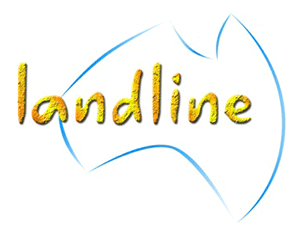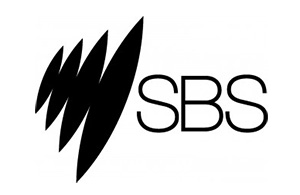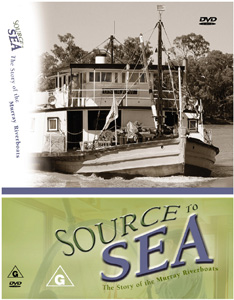If you are interested in working and historic paddle steamers, riverboats and barges, then you will really enjoy watching our Paddle Steamer DVD.
Purchase the
'Source to Sea' DVD
Sold in support of the RFDS
The Source to Sea documentary has aired on:



![]()
Media Release 
27th August 2003
Source to Sea – NOW on DVD
The 150th anniversary of the birth of the Murray River trade is being celebrated along the length of the river during August and September. A 104-minute interactive DVD of the highly acclaimed documentary Source to Sea – the Story of the Murray Riverboats has been produced to coincide with this significant milestone. The program aired on ABC TV’s Landline in January, is available in ABC Shops and is currently programmed on Qantas InFlight entertainment both domestically and internationally.
The new DVD, distributed by and in support of the Royal Flying Doctor Service, has numerous special features including extended interviews with the river skippers, the history of the river in black & white, the rhythm of steam, a montage of the riverboats and individual scene selection.
The Randell and Cadell River Run re-enactment from August 9th to September 6th commemorates an historic event involving Captain William Randell and Captain Francis Cadell and their paddle steamers the PS Mary Ann and the PS Lady Augusta.
At 10.00 am on Monday August 15th 1853 Captain William Richard Randell, on board Australia’s first steam driven paddleboat, the 55 ft PS Mary Ann departed Mannum for an historic journey up the Murray River. William Randell was 29 and this adventure, many argue, earns Randell the title of ‘Father of the Murray River Trade’.
Explorer Charles Sturt discovered and named the Murray in 1830. Until William Randell’s experimental vessel was launched the first time on February 19th 1853, no one had seriously attempted to navigate the river in a boat of size to exploit the potentially rich commercial opportunities offered by such a daring enterprise.
William Randell was driven by a fascination with the river, the excitement of steam and the belief he would make his fortune if he could carry general supplies and flour, produced in his family’s mill at Gumeracha on the eastern slopes of the Adelaide Hills, to the miners on the booming Victorian gold fields. The most direct route was by the river. Until August 1853, no one had ever attempted such a journey.
At the same time at Goolwa at the Murray mouth, Captain Francis Cadell was fitting out the Sydney built 97 ft PS Lady Augusta and overseeing the construction of the barge Eureka. Francis Cadell had considerable financial assistance from the public purse and political support from the South Australian establishment and Lieutenant Governor Henry Fox Young.
Francis Cadell was determined to win the purse offered by the South Australian legislature in 1851 for “£4,000 to be equally divided between the first two iron steamers of not less than 40 horse power .. as shall successfully navigate the waters of the River Murray from Goolwa to the junction of the Darling”. Cadell negotiated with Fox Young to modify the terms to eliminate ‘iron’ and ‘horse power’ specifications and to have the purse paid for one steamer and one barge.
These were exciting times and amidst a fanfare of pomp and celebration, with the Eureka lashed alongside; the PS Lady Augusta departed Goolwa on August 25th 1853. On board was a distinguished party of 43 people including Lieutenant Governor Fox Young. The result was an unexpected ‘race’ between these two pioneering paddle steamers.
The PS Lady Augusta caught up with and passed the PS Mary Ann just above the junction of the Murrumbidgee River at 10.30 on the evening of Wednesday September 14th. They were within days of Swan Hill and both Captains pushed their vessels hard. The lead changed on a number of occasions during the following day and towards nightfall, Randell and Cadell agreed to a cessation of the race. They were putting too much pressure on their prototype paddlesteamers.
The PS Lady Augusta arrived at Swan Hill at 11.00 am two days later on Saturday September 17th. Six hours after Cadell arrived, Captain William Randell and the PS Mary Ann berthed at Swan Hill to a volley of shots from the local constabulary. The population of Swan Hill in 1853 was just 27. Captain Francis Cadell and the PS Lady Augusta claimed £2,000 of the £4,000 purse. This unusual ‘race’ was the start of a remarkable chapter in the colourful history of Australia’s Murray riverboats.
In August and September 2003, the events of 1853 and the significant river trade that followed are being remembered and celebrated along the length of the Murray in the Randell and Cadell River Run.
Replicas of both these historic vessels and fifteen large steamers and heritage boats from three States are taking part in the celebrations. Along the river, various other vessels are being built, restored or refurbished in time for this historic journey.
The PV Hebe has been restored by Mick and Kerry Knight at Waikerie in South Australia’s Riverland for the ‘Run’ - the PS William Randell, built by Roly Bartlett at Goolwa in 1998 and named after the man Roly believes to be the ‘Father’ of the river trade is there as is the Goolwa based 1908 PS Oscar W. Peter and Jan Teakle’s completely restored and refurbished 1875 PV Akuna Amphibious has had more than two million dollars spent on her over the past four years getting her ready for the re-enactment.
River communities and service clubs are joining the celebrations and the organisers are encouraging other more conventional river vessels to also join the flotilla. Australia has more original wooden steam powered paddleboats than anywhere else in the world.
The last time they gathered in such numbers was for the Centenary of Federation’s ‘Source to Sea’ celebrations in 2001. Documentary makers Ian Doyle and Paul Williams followed the flotilla and produced Source to Sea – the Story of the Murray Riverboats.
“It’s a story about passion and love - passion for old paddle steamers and love of a river. We were extremely fortunate to gain access to private archival footage from the Robinson family at Chowilla Station and historic photographs from the Rod Williams collection at the Mannum Heritage Centre. The documentary celebrates the unique and largely untold story of the Murray riverboats,” Ian Doyle said.
Source to Sea - the Story of the Murray Riverboats brings to life the remarkable history of a number of the old riverboats and shows the dedication of an increasing number of 'passionately mad' wooden boat restorers who are refloating and rebuilding sunken treasures along the Murray.
The documentary includes the story of steam; the hard work, the humour and the romance of the river trade in the late 1800's when several hundred paddleboats and barges opened up much of inland Australia along the Murray, Darling and Murrumbidgee Rivers.
“There’s no doubt in my mind that the ‘Father of the Murray River trade’ title should go to the visionary farmer from Gumeracha William Randell. His PS Mary Ann was the first boat launched on the Murray 150 years ago and while he didn’t get to Swan Hill before Cadell, he did it largely by himself. I’ve also no doubt that many good bottles of port will be consumed during the Randell and Cadell River Run arguing the case for both of these pioneering river men,” Ian Doyle said.
The new 104-minute DVD of Source to Sea - the Story of the Murray Riverboats is being officially launched on September 14th at the Australian National Museum in Canberra. Proceeds from the sale of the program are in support of the Royal Flying Doctor Service and can be purchased by ringing the RFDS on free call 1800 813 318.
More information:
Ian Doyle John Tobin
Executive Producer Marketing Manager
Source to Sea RFDS
0417 819 189 08 8238 3333


